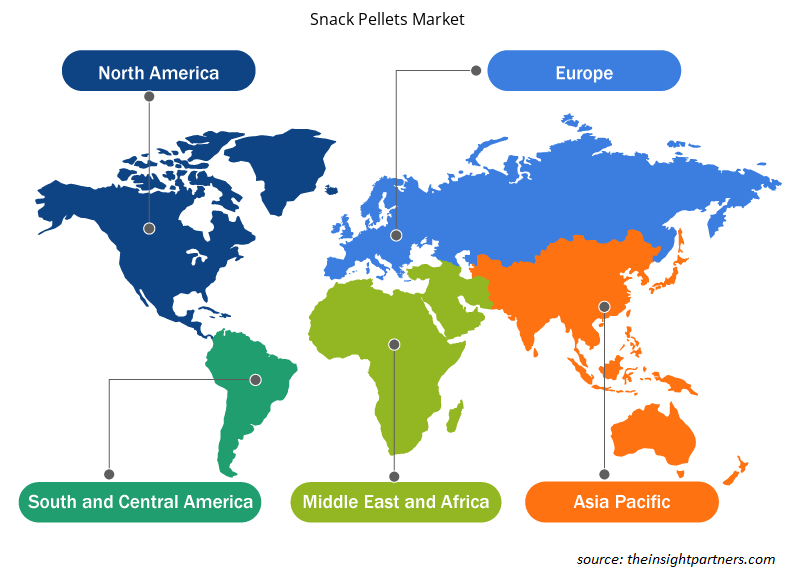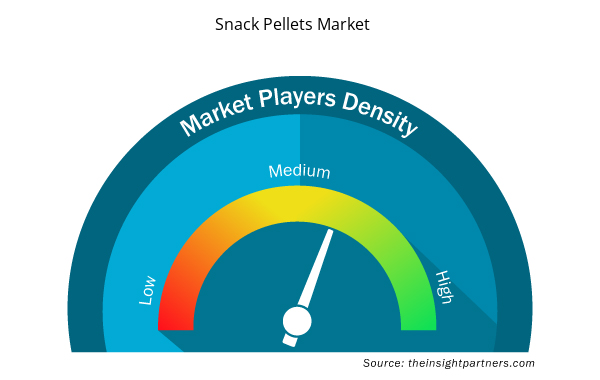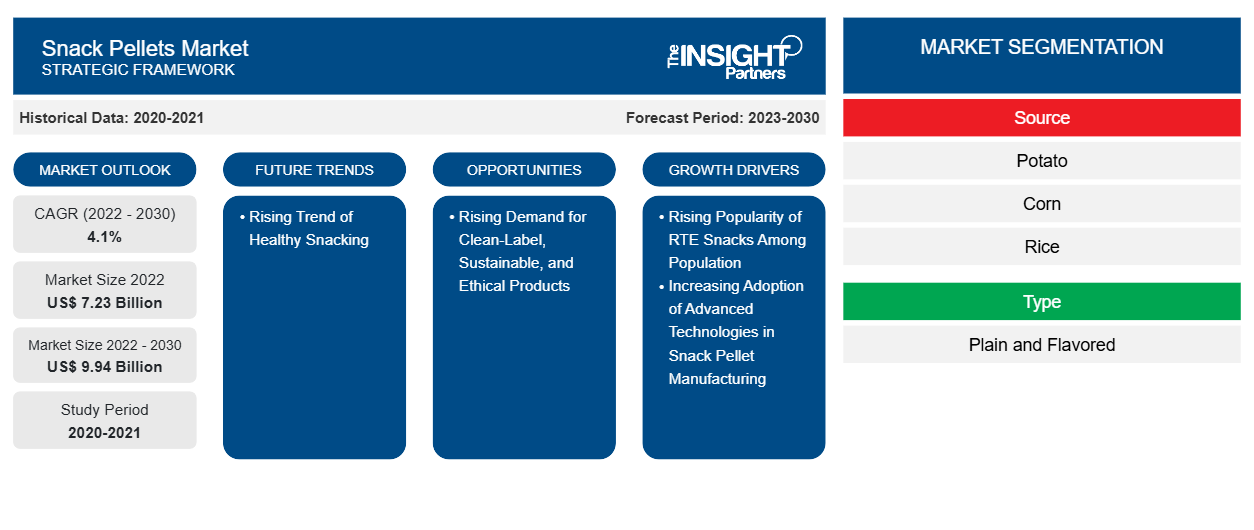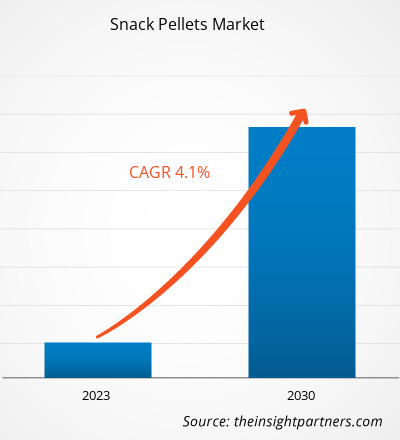[Forschungsbericht] Der Markt für Snackpellets soll von 7.228,70 Millionen US-Dollar im Jahr 2022 auf 9.935,20 Millionen US-Dollar im Jahr 2030 wachsen; der Markt soll von 2022 bis 2030 eine durchschnittliche jährliche Wachstumsrate (CAGR) von 4,1 % verzeichnen.
Markteinblicke und Analystenansichten:
Snackpellets sind nicht expandierte Produkte aus Rohstoffen wie Kartoffeln, Mais, Reis, Tapioka, Mehrkorn und anderen. Diese Pellets werden getrocknet und halbverarbeitet hergestellt, um eine einfache Lagerung und einen einfachen Versand zu gewährleisten. Diese halbverarbeiteten Produkte werden an Snackhersteller verkauft, wo sie mit verschiedenen Methoden wie Frittieren und Heißluftbacken weiterverarbeitet werden. Die Nachfrage nach Snackpellets ist auf die steigende Nachfrage nach Fertiggerichten und die zunehmende Einführung fortschrittlicher Technologien bei der Herstellung von Snackpellets zurückzuführen. Die steigende Nachfrage nach Snackpellets dürfte daher das Wachstum des Marktes für Snackpellets vorantreiben .
Wachstumstreiber und Herausforderungen:
Auch verzehrfertige Snacks erfreuen sich einer enormen Nachfrage, insbesondere unter Berufstätigen, da in Unternehmen immer mehr Menschen zum Naschen neigen. Kleine Kaffee- und Snackpausen zum Abbau von Arbeitsstress treiben die Nachfrage nach verzehrfertigen Snacks an. Leichte Snacks wie Popcorn, Chips und Puffs sind bei der jüngeren Bevölkerung und Kindern beliebt. Die steigende Beliebtheit verzehrfertiger Snacks bei den Verbrauchern und wachsende Innovationen treiben den globalen Markt für Snackpellets an. Darüber hinaus hat sich die Extrusionstechnologie, ein entscheidender Prozess bei der Herstellung von Snackpellets, weiterentwickelt, sodass Hersteller vielfältige Snackprodukte mit verbesserter Qualität, Textur und Geschmack herstellen können. Diese technologischen Fortschritte haben die Produktionseffizienz erhöht und die Entwicklung innovativer und ansprechender Snackoptionen ermöglicht, die den sich ändernden Vorlieben der Verbraucher gerecht werden. Die Einführung von Doppelschneckenextrudern, die Integration von 3D-Druck und die Einführung intelligenter Steuerungen und Automatisierung kurbeln die Produktion einer vielfältigen Palette von Snackpellets an und befeuern das Wachstum des globalen Marktes für Snackpellets. Schwankungen bei den Preisen wichtiger Rohstoffe wie Getreide und Hülsenfrüchte können sich jedoch direkt auf die Kostenstruktur der Hersteller von Snackpellets auswirken. Da Snackpellets stark von diesen Rohstoffen abhängen, kann jede erhebliche Kostensteigerung zu steigenden Produktionskosten führen. Somit bremsen die gestiegenen Produktionskosten das Wachstum des globalen Marktes für Snackpellets.
Passen Sie diesen Bericht Ihren Anforderungen an
Sie erhalten kostenlos individuelle Anpassungen an jedem Bericht, einschließlich Teilen dieses Berichts oder einer Analyse auf Länderebene, eines Excel-Datenpakets sowie tolle Angebote und Rabatte für Start-ups und Universitäten.
- Holen Sie sich die wichtigsten Markttrends aus diesem Bericht.Dieses KOSTENLOSE Beispiel umfasst eine Datenanalyse von Markttrends bis hin zu Schätzungen und Prognosen.
Berichtssegmentierung und -umfang:
Der „globale Markt für Snackpellets“ ist nach Quelle, Typ, Form und Geografie segmentiert. Basierend auf der Quelle ist der Markt für Snackpellets in Kartoffeln, Mais, Reis, Tapioka, Mehrkorn und andere unterteilt. Basierend auf dem Typ ist der Markt in aromatisiert und natur unterteilt. In Bezug auf die Form ist der Markt für Snackpellets in laminiert, mit Prägefläche, dreidimensionales Material und andere unterteilt. Basierend auf der Geografie ist der Markt in Nordamerika (USA, Kanada und Mexiko), Europa (Deutschland, Frankreich, Italien, Großbritannien, Russland und der Rest von Europa), Asien-Pazifik (Australien, China, Japan, Indien, Südkorea und der Rest von Asien-Pazifik), Naher Osten und Afrika (Südafrika, Saudi-Arabien, die Vereinigten Arabischen Emirate und der Rest von Nahem Osten und Afrika) und Süd- und Mittelamerika (Brasilien, Argentinien und der Rest von Süd- und Mittelamerika) unterteilt.
Segmentanalyse:
Der Markt für Snackpellets ist nach Herkunft in Kartoffeln, Mais, Reis, Tapioka, Mehrkorn und andere unterteilt. Das Kartoffelsegment hält einen erheblichen Marktanteil. Die Nachfrage nach Kartoffelsnackpellets steigt bei Snackherstellern aufgrund ihrer großen Beliebtheit, ihres Status als Hausmannskost und der anhaltenden Verbrauchernachfrage nach Snacks auf Kartoffelbasis. Diese Pellets können frittiert oder gebacken werden, um einen knusprigen und leckeren Snack herzustellen. Hersteller fragen Kartoffelsnackpellets nach, da Verbraucher Kartoffelsnacks aufgrund ihres vertrauten Geschmacks, ihrer Textur und ihrer vielseitigen Geschmacksrichtung bevorzugen. Diese Faktoren werden voraussichtlich den Marktanteil des Segments steigern.
Regionale Analyse:
Geografisch ist der Markt für Snackpellets in fünf Hauptregionen unterteilt: Nordamerika, Europa, Asien-Pazifik, Süd- und Mittelamerika sowie Naher Osten und Afrika. Der globale Markt für Snackpellets wurde vom asiatisch-pazifischen Raum dominiert; der Markt in dieser Region wurde im Jahr 2022 auf 3472 Millionen US-Dollar geschätzt. Nordamerika ist der zweitgrößte Marktteilnehmer und hält fast 25 % des Weltmarkts. Süd- und Mittelamerika werden im Prognosezeitraum voraussichtlich eine durchschnittliche jährliche Wachstumsrate (CAGR) von 5,1 % auf dem Markt für Snackpellets verzeichnen. Das Wachstum des Marktes für Snackpellets in der Region ist auf die steigende Nachfrage nach Fertiggerichten, die zunehmende Einführung fortschrittlicher Technologien bei der Herstellung von Snackpellets und die zunehmende Entwicklung der Lebensmittelverarbeitungsindustrie in Volkswirtschaften wie China, Indien und Indonesien zurückzuführen. Zunehmend hektische Lebensstile, längere Arbeitszeiten und eine steigende Zahl von Haushalten mit Doppeleinkommen haben zum Wachstum von verpackten Lebensmitteln wie Chips und Popcorn beigetragen. Diese Faktoren werden voraussichtlich die Nachfrage nach Snackpellets im asiatisch-pazifischen Raum ankurbeln.
Darüber hinaus ist Europa eine der bedeutendsten Regionen für den Markt für Snackpellets. In Europa sind Snackpellets auf Kartoffelbasis bei den Verbrauchern weit verbreitet. Darüber hinaus wird erwartet, dass Snackpellets auf Maisbasis aufgrund der Einführung neuer Rezepte mit Maiszutaten an Popularität gewinnen. Der wachsende Konsum von Fertiggerichten und die Einführung neuer Snacks mit Geschmack sind die Hauptfaktoren, die voraussichtlich die Nachfrage nach Snackpellets in der Region ankurbeln werden.
Branchenentwicklungen und zukünftige Chancen:
Nachfolgend sind verschiedene Initiativen wichtiger Akteure auf dem Markt für Snackpellets aufgeführt:
- Im September 2022 brachte Pringles, eine Snackmarke der Kellogg Company, Mehrkorn- und Süßkartoffelchips mit dem Anspruch auf Nicht-HFSF (ohne hohen Fett-, Zucker- und Salzgehalt) auf den Markt. Diese Chips werden aus Weizen, Gerste, schwarzen Bohnen und Süßkartoffeln hergestellt, die großartige Ballaststoff-, Protein- und gute Kohlenhydratequellen sind und in innovativen Geschmacksrichtungen wie Sea Salt, Smoky BBQ, Homestyle Ranch und Farmhouse Cheddar erhältlich sind.
- Im Juni 2022 entwickelte die GEA Group ein neues Snackformat namens „Cinderella’s Slippers“, ein Snackpellet in Form eines Pantoffels. Das neue Format wurde entwickelt, um die Herausforderung zu meistern, die Snacks in die Soße zu tunken, ohne sich die Finger zu bedecken.
- Im Jahr 2022 kündigte LENG-D'OR SAU, ein in Spanien ansässiger Hersteller von Snackpellets, seine Kapazitätserweiterung in Spanien und den USA an, um mehr als 338,95 Millionen US-Dollar pro Jahr zu erreichen.
Auswirkungen von COVID-19:
Die COVID-19-Pandemie betraf fast alle Branchen in verschiedenen Ländern. Lockdowns, Reisebeschränkungen und Betriebsschließungen in Nordamerika, Europa, im asiatisch-pazifischen Raum (APAC), in Süd- und Mittelamerika (SAM) sowie im Nahen Osten und Afrika (MEA) behinderten das Wachstum mehrerer Branchen, darunter auch der Lebensmittel- und Getränkeindustrie. Die Schließung von Produktionseinheiten störte die globalen Lieferketten, Fertigungsaktivitäten, Lieferpläne sowie den Verkauf lebensnotwendiger und nicht lebensnotwendiger Produkte. Verschiedene Unternehmen erlebten im Jahr 2020 Verzögerungen bei der Produktlieferung und einen Einbruch der Verkäufe ihrer Produkte, was sich negativ auf den Markt für Snackpellets auswirkte.
Während der COVID-19-Pandemie wurden Betrieb und Prozesse weltweit aufgrund des Mangels an Arbeitskräften und der begrenzten Versorgung mit Rohstoffen eingestellt. Im Zuge der Pandemie stieg die Nachfrage nach gesunden Snacks jedoch deutlich an, da die Verbraucher auf ihre Gesundheit und ihr allgemeines Wohlbefinden achteten. Daher konzentrierten sich die Hersteller auf die Einführung neuer Produkte mit verschiedenen Nährwertaussagen wie biologisch, glutenfrei, proteinreich, sojafrei, frei von gentechnisch veränderten Organismen (GVO) und allergenfrei. Der Anstieg dieses Trends während der Pandemie wirkte sich positiv auf den Markt für Snackpellets aus.
Im Jahr 2021 nahmen viele Volkswirtschaften ihren Betrieb wieder auf, da mehrere Regierungen Lockerungen der zuvor verhängten Beschränkungen ankündigten, was sich positiv auf den Weltmarkt auswirkte. Darüber hinaus durften die Hersteller mit voller Kapazität arbeiten, was ihnen half, die Lücke zwischen Angebot und Nachfrage zu schließen.
Regionale Einblicke in den Markt für Snackpellets
Die regionalen Trends und Faktoren, die den Markt für Snackpellets im Prognosezeitraum beeinflussen, wurden von den Analysten von Insight Partners ausführlich erläutert. In diesem Abschnitt werden auch die Marktsegmente und die Geografie von Snackpellets in Nordamerika, Europa, im asiatisch-pazifischen Raum, im Nahen Osten und Afrika sowie in Süd- und Mittelamerika erörtert.

- Erhalten Sie regionale Daten zum Markt für Snackpellets
Umfang des Marktberichts zu Snackpellets
| Berichtsattribut | Details |
|---|---|
| Marktgröße im Jahr 2022 | 7,23 Milliarden US-Dollar |
| Marktgröße bis 2030 | 9,94 Milliarden US-Dollar |
| Globale CAGR (2022 - 2030) | 4,1 % |
| Historische Daten | 2020-2021 |
| Prognosezeitraum | 2023–2030 |
| Abgedeckte Segmente | Nach Quelle
|
| Abgedeckte Regionen und Länder | Nordamerika
|
| Marktführer und wichtige Unternehmensprofile |
|
Dichte der Marktteilnehmer für Snackpellets: Auswirkungen auf die Geschäftsdynamik verstehen
Der Markt für Snackpellets wächst rasant, angetrieben durch die steigende Endverbrauchernachfrage aufgrund von Faktoren wie sich entwickelnden Verbraucherpräferenzen, technologischen Fortschritten und einem größeren Bewusstsein für die Vorteile des Produkts. Mit steigender Nachfrage erweitern Unternehmen ihr Angebot, entwickeln Innovationen, um die Bedürfnisse der Verbraucher zu erfüllen, und nutzen neue Trends, was das Marktwachstum weiter ankurbelt.
Die Marktteilnehmerdichte bezieht sich auf die Verteilung der Firmen oder Unternehmen, die in einem bestimmten Markt oder einer bestimmten Branche tätig sind. Sie gibt an, wie viele Wettbewerber (Marktteilnehmer) in einem bestimmten Marktraum im Verhältnis zu seiner Größe oder seinem gesamten Marktwert präsent sind.
Die wichtigsten auf dem Markt für Snackpellets tätigen Unternehmen sind:
- Bach Snacks SAL
- Snack Creations Ltd
- Balance Foods Inc
- LENG-D'OR SAU
- Qualitätspellets AS
Haftungsausschluss : Die oben aufgeführten Unternehmen sind nicht in einer bestimmten Reihenfolge aufgeführt.

- Überblick über die wichtigsten Akteure auf dem Markt für Snackpellets
Wettbewerbslandschaft und Schlüsselunternehmen:
Einige der führenden Akteure auf dem globalen Markt für Snackpellets sind Bach Snacks SAL, Snack Creations Ltd, Balance Foods Inc, LENG-D'OR SAU, Quality Pellets AS, JR Short Milling Co, Le Caselle SpA, Mafin SRL, Noble Agro Food Products Pvt Ltd und Societe Cooperative Agricole Limagrain. Diese Marktteilnehmer ergreifen strategische Entwicklungsinitiativen, um zu expandieren und das Wachstum des Marktes für Snackpellets weiter voranzutreiben.
- Historische Analyse (2 Jahre), Basisjahr, Prognose (7 Jahre) mit CAGR
- PEST- und SWOT-Analyse
- Marktgröße Wert/Volumen – Global, Regional, Land
- Branche und Wettbewerbsumfeld
- Excel-Datensatz



Report Coverage
Revenue forecast, Company Analysis, Industry landscape, Growth factors, and Trends

Segment Covered
This text is related
to segments covered.

Regional Scope
North America, Europe, Asia Pacific, Middle East & Africa, South & Central America

Country Scope
This text is related
to country scope.
Häufig gestellte Fragen
The major players operating in the global snack pellets market are Bach Snacks SAL, Snack Creations Ltd, Balance Foods Inc, LENG-D'OR SAU, Quality Pellets AS, J.R. Short Milling Co, Le Caselle SpA, Mafin SRL, Noble Agro Food Products Pvt Ltd, and Societe Cooperative Agricole Limagrain among few others.
The rising demand for clean-label, ethical, and sustainable snacking products is expected to open potential opportunities in the global snack pellets market.
Based on the type, the plain segment accounted for the largest revenue share as their compatibility with traditional regional spices and seasonings. Snack manufacturers can customize the flavorings to suit their preferences, ranging from spicy, savory, and tangy to sweet, making plain snack pellets a versatile and appealing choice.
Increased demand for convenient and tasty snacks among the young generation has driven snack pellet manufacturing in the South & Central America. In addition, rapid urbanization and the availability of raw materials in the region have contributed to the growth of the snack pellets market.
Rising popularity of RTE snacks among population increasing adoption of advanced technologies in snack pellet manufacturing are some of the key driving factors for the snack pellets market.
Based on form, Tri-dimensional is the fastest-growing segment in the snack pellets market. The demand for tri-dimensional snack pellets is upsurging as snack manufacturers recognize the positive impact of unique shapes on consumer engagement.
Trends and growth analysis reports related to Food and Beverages : READ MORE..
The List of Companies - Snack Pellets Market
- Bach Snacks SAL
- Snack Creations Ltd
- Balance Foods Inc
- LENG-D'OR SAU
- Quality Pellets AS
- J.R. Short Milling Co
- Le Caselle SpA
- Mafin SRL
- Noble Agro Food Products Pvt Ltd
- Societe Cooperative Agricole Limagrain
The Insight Partners performs research in 4 major stages: Data Collection & Secondary Research, Primary Research, Data Analysis and Data Triangulation & Final Review.
- Data Collection and Secondary Research:
As a market research and consulting firm operating from a decade, we have published and advised several client across the globe. First step for any study will start with an assessment of currently available data and insights from existing reports. Further, historical and current market information is collected from Investor Presentations, Annual Reports, SEC Filings, etc., and other information related to company’s performance and market positioning are gathered from Paid Databases (Factiva, Hoovers, and Reuters) and various other publications available in public domain.
Several associations trade associates, technical forums, institutes, societies and organization are accessed to gain technical as well as market related insights through their publications such as research papers, blogs and press releases related to the studies are referred to get cues about the market. Further, white papers, journals, magazines, and other news articles published in last 3 years are scrutinized and analyzed to understand the current market trends.
- Primary Research:
The primarily interview analysis comprise of data obtained from industry participants interview and answers to survey questions gathered by in-house primary team.
For primary research, interviews are conducted with industry experts/CEOs/Marketing Managers/VPs/Subject Matter Experts from both demand and supply side to get a 360-degree view of the market. The primary team conducts several interviews based on the complexity of the markets to understand the various market trends and dynamics which makes research more credible and precise.
A typical research interview fulfils the following functions:
- Provides first-hand information on the market size, market trends, growth trends, competitive landscape, and outlook
- Validates and strengthens in-house secondary research findings
- Develops the analysis team’s expertise and market understanding
Primary research involves email interactions and telephone interviews for each market, category, segment, and sub-segment across geographies. The participants who typically take part in such a process include, but are not limited to:
- Industry participants: VPs, business development managers, market intelligence managers and national sales managers
- Outside experts: Valuation experts, research analysts and key opinion leaders specializing in the electronics and semiconductor industry.
Below is the breakup of our primary respondents by company, designation, and region:

Once we receive the confirmation from primary research sources or primary respondents, we finalize the base year market estimation and forecast the data as per the macroeconomic and microeconomic factors assessed during data collection.
- Data Analysis:
Once data is validated through both secondary as well as primary respondents, we finalize the market estimations by hypothesis formulation and factor analysis at regional and country level.
- Macro-Economic Factor Analysis:
We analyse macroeconomic indicators such the gross domestic product (GDP), increase in the demand for goods and services across industries, technological advancement, regional economic growth, governmental policies, the influence of COVID-19, PEST analysis, and other aspects. This analysis aids in setting benchmarks for various nations/regions and approximating market splits. Additionally, the general trend of the aforementioned components aid in determining the market's development possibilities.
- Country Level Data:
Various factors that are especially aligned to the country are taken into account to determine the market size for a certain area and country, including the presence of vendors, such as headquarters and offices, the country's GDP, demand patterns, and industry growth. To comprehend the market dynamics for the nation, a number of growth variables, inhibitors, application areas, and current market trends are researched. The aforementioned elements aid in determining the country's overall market's growth potential.
- Company Profile:
The “Table of Contents” is formulated by listing and analyzing more than 25 - 30 companies operating in the market ecosystem across geographies. However, we profile only 10 companies as a standard practice in our syndicate reports. These 10 companies comprise leading, emerging, and regional players. Nonetheless, our analysis is not restricted to the 10 listed companies, we also analyze other companies present in the market to develop a holistic view and understand the prevailing trends. The “Company Profiles” section in the report covers key facts, business description, products & services, financial information, SWOT analysis, and key developments. The financial information presented is extracted from the annual reports and official documents of the publicly listed companies. Upon collecting the information for the sections of respective companies, we verify them via various primary sources and then compile the data in respective company profiles. The company level information helps us in deriving the base number as well as in forecasting the market size.
- Developing Base Number:
Aggregation of sales statistics (2020-2022) and macro-economic factor, and other secondary and primary research insights are utilized to arrive at base number and related market shares for 2022. The data gaps are identified in this step and relevant market data is analyzed, collected from paid primary interviews or databases. On finalizing the base year market size, forecasts are developed on the basis of macro-economic, industry and market growth factors and company level analysis.
- Data Triangulation and Final Review:
The market findings and base year market size calculations are validated from supply as well as demand side. Demand side validations are based on macro-economic factor analysis and benchmarks for respective regions and countries. In case of supply side validations, revenues of major companies are estimated (in case not available) based on industry benchmark, approximate number of employees, product portfolio, and primary interviews revenues are gathered. Further revenue from target product/service segment is assessed to avoid overshooting of market statistics. In case of heavy deviations between supply and demand side values, all thes steps are repeated to achieve synchronization.
We follow an iterative model, wherein we share our research findings with Subject Matter Experts (SME’s) and Key Opinion Leaders (KOLs) until consensus view of the market is not formulated – this model negates any drastic deviation in the opinions of experts. Only validated and universally acceptable research findings are quoted in our reports.
We have important check points that we use to validate our research findings – which we call – data triangulation, where we validate the information, we generate from secondary sources with primary interviews and then we re-validate with our internal data bases and Subject matter experts. This comprehensive model enables us to deliver high quality, reliable data in shortest possible time.


 Holen Sie sich ein kostenloses Muster für diesen Bericht
Holen Sie sich ein kostenloses Muster für diesen Bericht